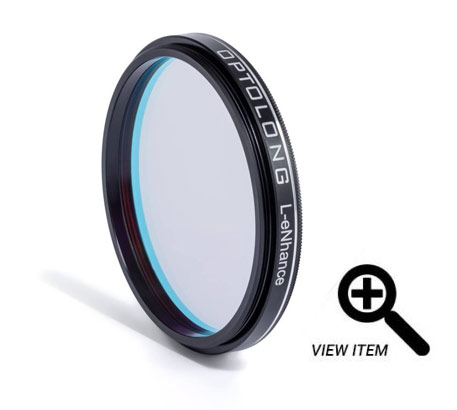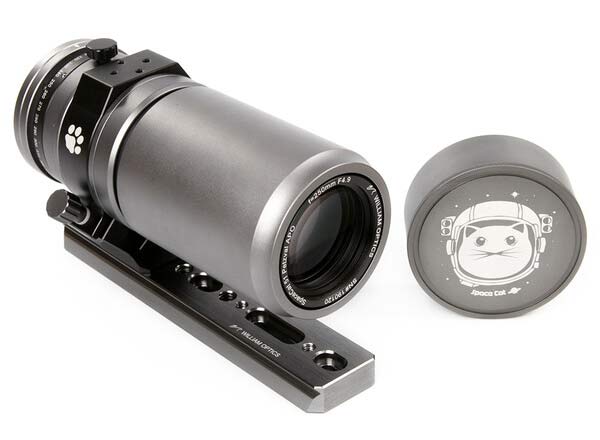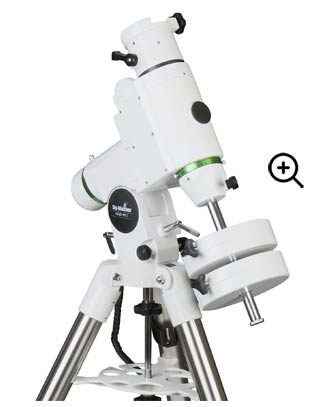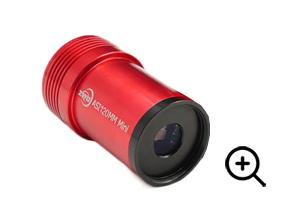Backyard of the Week | July 26, 2021
The AstroBackyard Backyard of the Week highlights astrophotography setups from around the world. A “backyard” can be a balcony, driveway, garden, or wherever else you set up astrophotography equipment at home.
By taking a behind-the-scenes look at the equipment amateur astrophotographers use to take deep-sky images, you can get a better understanding of the process.
This week’s backyard astrophotography equipment profile comes to us from Katie Hughes in Scotland.
Location: Loch Lomond, Scotland
Since we began the Backyard of the Week feature, I’ve seen a lot of astrophotography equipment configurations that contain many of the same pieces of gear that I personally own and enjoy. But Katie’s is the first one that consists entirely of equipment I’ve spent many nights using in the backyard.
At the heart of this setup, is the reliable workhorse known as the Sky-Watcher HEQ5 equatorial mount. This setup is as about as lightweight and portable as it gets for deep-sky imaging with a telescope and autoguiding system.
Katie has recently upgraded to a dedicated astronomy camera from her DSLR, and I know she is excited to start using it for deep-sky imaging in the backyard.
I have a special place in my heart for those shooting in cloudy locations. You have to wait patiently night after night for the clouds to part, and a surprise clear night means canceling all other plans to photograph the sky.
Katie Hughes
Katie is a proud member of STELA (Striving To Engage Ladies in Astrophotography). She represents a passionate collection of women from around the globe united by the wonders of the night sky.
Katie also supports the efforts to rebuild the Scottish Dark Sky Observatory (SDSO) following the terrible destruction of the facility that occurred in June 2021. She even organized raffle donations in support of the re-build, collecting prints from generous astrophotographers from around the world.
Ashley and I donated a metallic print of the Andromeda Galaxy to this cause, and we are grateful to have someone like Katie representing the astrophotography community in a time like this. Thank you for all you do, Katie!
The Flaming Star Nebula and Tadpoles Nebula.
The image shown above is incredibly well executed from acquisition to processing. I consider this to be Katie’s best astrophoto to date. The creative processing highlights the brightest stars in the region that split the two nebulae regions up in Auriga.
The framing, color, and overall impact of the image make this an inspiring resource for anyone looking to give this region a go.
This image was captured using Katie’s equipment shown above, with a Canon EOS Rebel XSi (450D) camera in place of the ZWO ASI533MC Pro.
Although the image below wasn’t taken with the setup featured on this page, I just had to share this beautiful sight of the Aurora from her location.
The Northern Lights in Scotland by Katie Hughes.
Katie’s Equipment
| Primary Imaging Camera | ZWO ASI533MC Pro |
| Primary Imaging Telescope | William Optics SpaceCat 51 |
| Telescope Mount | Sky-Watcher HEQ5 Pro |
| Filter | Optolong L-eNhance |
| Guide Scope | William Optics 50mm Guide Scope |
| Guide Camera | ZWO ASI120MM Mini |
What does Katie love most about her gear?
‘My SpaceCat 51’
I am not surprised Katie chose her telescope as the most important part of her setup. A wide-field APO refractor telescope is one of the most practical choices possible for deep-sky astrophotography.
They’re compact, lightweight, and very forgiving in terms of tracking accuracy. A larger telescope with more reach may pull planets and small galaxies in closer, but it will also magnify any subtle tracking and autoguiding issues of your telescope mount.
Katie’s Deep-Sky Astrophotography Setup.
The Camera
The ZWO ASI533 Pro is a remarkable little camera. The pixel size (3.76 um) and resulting image scale through a wide-field refractor make this one of my personal favorites to use in the backyard. The ASI533MC Pro uses a one-shot-color cooled CMOS sensor to record deep-sky images in detail will an impressive dynamic range and low read-out noise.
A 1″ 9 MP sensor records images that are exactly 3008 x 3008 pixels in size when binned 1×1. The full well capacity of the 533MC Pro is 50,000e (compared to 15,000e in the 183MC Pro) and it can also shoot in 14-bit ADC. This results in a massive dynamic range of light values in a single exposure.
The ZWO ASI533MC Pro.
Katie’s equipment profile reminded me to utilize my ASI533MC Pro, a camera that has not seen enough photons since mine arrived in late 2019. I recently paired this camera to the Radian 61 triplet APO, and the crispy image scale (2.81 arc-seconds/pixel) is perfect for wide-field nebulae projects. (I’ll share my results with this configuration on YouTube soon).
The Filter
Katie uses an Optolong L-eNhance filter to separate the good light from the bad. It’s a fantastic choice for the ZWO ASI533MC Pro, and especially handy on emission nebulae targets with a strong signal in Ha and OIII.
The 2″ round-mounted version easily threads onto an M48 adapter or inside of a filter drawer. The large size means that you can use the filter without experience any vignetting up to a full-frame sensor camera.
The Telescope
This telescope is so popular in the astrophotography community, William offers it a variety of names, colors, and versions. Katie owns the William Optics SpaceCat 51 variation, a sleek grey version of the William Optics RedCat version 2.
At a focal length of 275mm, massive deep-sky objects like the North America Nebula and the Andromeda Galaxy are within reach. This field of view is well appreciated when using a smaller camera sensor like a micro-four-thirds (ASI294MC Pro), or 1″ square (ASI533MC Pro).
I am a big fan of this telescope, its ultra-flat field, and its sharp optics. The image scale is jaw-dropping when you pair it with a full-frame camera such as the Canon EOS Ra. The 3.76-micron pixels of the ASI2600MC Pro and ASI533MC Pro are also a great match with the SpaceCat if you’re tired of oversampled images.
The William Optics SpaceCat 51.
William Optics SpaceCat 51 Specifications
- Type: Apochromatic Refractor
- Diameter: 51mm
- Focal Length: 250mm
- Focal Ratio: f/4.9
- Field Flattener: N/A
- Tube Weight: 3.2 lbs (1.4 kg)
The Telescope Mount
The Skywatcher HEQ5 Pro is the ultimate first GoTo equatorial mount for anyone looking to shoot longer and deeper. I have a personal attachment to the HEQ5 is it brought me some of my best astrophotography images early on in my career.
If you don’t need the extra payload capacity of the slightly larger EQ6-R Pro, the HEQ5 is a great choice. The SynScan system allows you to select deep-sky objects from a database of over 40K items from double stars to planetary nebulae.
The Sky-Watcher HEQ5 Pro.
The autoguiding port allows you to refine the tracking accuracy of the HEQ5 using a small guide camera. With an accurate polar alignment and balanced load, the HEQ5 is capable of taking 10-minute exposures when autoguiding is employed.
The Guide Scope
Guide scopes don’t need to be fancy to do their job. The Williams Optics 50mm exemplifies this by providing a useful 200mm focal length at F/4 in a lightweight package.
The 1.25″ Rotolock feature is a nice perk over some of the more generic guide scopes on the market. A 50mm guide scope will serve you well for autoguiding a telescope in the 250-800mm range.
William Optics 50mm Guide Scope.
The Guide Camera
I have officially run out of ways to cleverly describe the ZWO ASI120MM Guide Camera. To prove this point, I have copied and pasted this exact description from last week’s featured setup.
If you need a camera for autoguiding that works every time, consider adding the ZWO ASI120MM Mini to your wish list.
ZWO ASI120MM Mini.
Thank you for sharing your backyard astrophotography set up with us, Katie! You can view Katie’s astrophotography on Instagram.
Be sure to fill out the form to submit your backyard for a chance to be featured, and don’t forget to include your Instagram handle to help grow your following.
View the Backyard of the Week Archives









